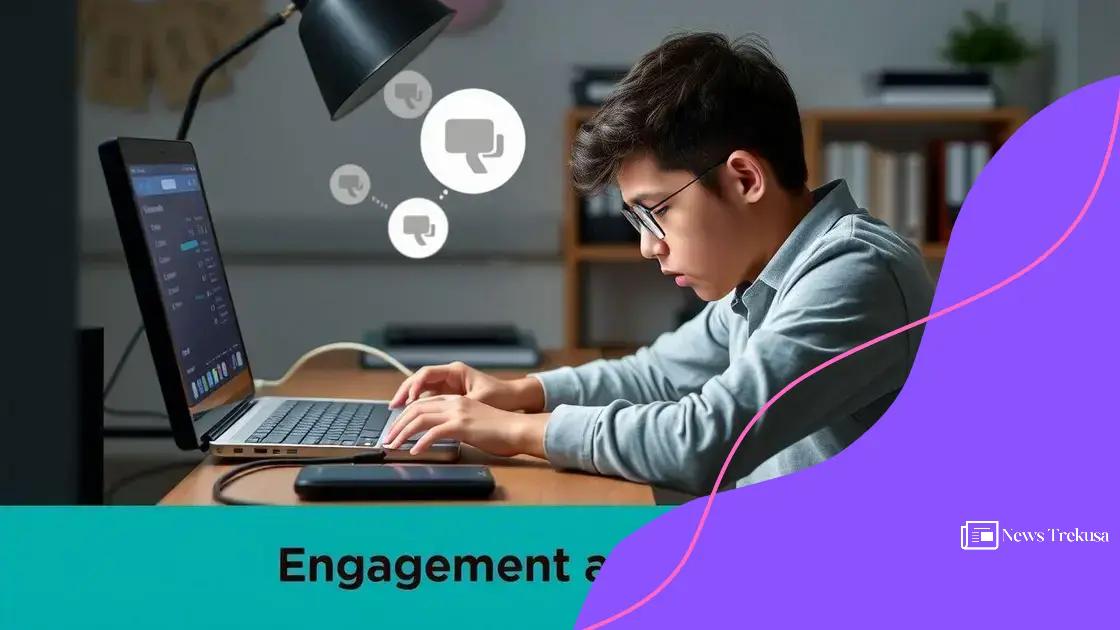Remote learning effectiveness: Is it truly beneficial?

Remote learning effectiveness refers to the ability of online education to meet learning objectives, characterized by flexible schedules, diverse resources, and the successful use of technology to engage students.
Remote learning effectiveness has become a focal point in education. With shifting dynamics due to global events, understanding its true impact is crucial for students and teachers alike. Curious about how it affects learning outcomes? Let’s dive in!
Understanding remote learning effectiveness
Understanding remote learning effectiveness is crucial in today’s educational landscape. With many students learning from home, it’s important to assess whether this mode of learning truly benefits learners and educators.
Defining remote learning effectiveness
Remote learning effectiveness refers to the ability of online educational methods to achieve learning objectives. This includes how well students grasp the material, stay engaged, and develop skills necessary for success. Examining these factors reveals the strengths and weaknesses of remote learning.
Key components of effectiveness
Several aspects contribute to the success of remote learning:
- Student Engagement: Keeping students engaged is essential. Successful programs utilize interactive tools and resources that encourage participation.
- Accessibility: Effective remote learning should be accessible to all students, regardless of their background or resources.
- Instructional Methods: Employing diverse teaching strategies helps cater to different learning styles.
In addition to these components, teacher support plays a significant role. Educators need proper training to manage online classrooms effectively. This includes using technology and providing feedback. When teachers feel equipped to handle remote learning, student outcomes tend to improve.
Measuring remote learning effectiveness
To assess effectiveness, schools can employ various methods, like tracking student participation and performance. Surveys and feedback from both students and parents provide valuable insight into the learning experience. By focusing on quantifiable data, institutions can adapt and enhance their remote programs.
Furthermore, it’s important to remember that the effectiveness of remote learning can vary widely among students. Some thrive in an online setting, while others may struggle without the traditional classroom environment. Tailoring educational approaches to fit individual needs can significantly boost remote learning effectiveness.
Key benefits of remote learning
Exploring the key benefits of remote learning helps us understand why this educational model has gained popularity. It offers unique advantages that can enhance the learning experience for students of all ages.
Flexibility in Learning
One of the most significant benefits is the flexibility it provides. Students can create their own schedules, allowing them to learn at their own pace. This is especially helpful for those who balance work, family, or other commitments.
Access to a Wide Range of Resources
Remote learning opens doors to a vast array of educational materials. Students can easily access online libraries, webinars, and interactive tools. This can lead to a deeper understanding of subjects since materials can be explored in different formats.
- Diverse Learning Styles: Online resources cater to various learning preferences, such as videos, articles, and interactive quizzes, making education more engaging.
- Global Access: Students can connect with peers and educators from all over the world, enriching their learning experience with global perspectives.
- Cost-Effectiveness: Remote learning can reduce costs related to commuting, housing, and textbook purchases.
Another benefit is the development of digital skills. In today’s tech-driven world, being familiar with digital platforms is essential. Remote learning encourages students to become more proficient with technology, preparing them for future careers.
Furthermore, remote learning promotes self-discipline and responsibility. Students must manage their time and commitments, which builds valuable life skills. As they navigate their learning environment, they learn to set goals and monitor their progress.
Common challenges faced in remote learning

Remote learning has transformed education, but it also brings various common challenges that can impact students and teachers alike. Understanding these obstacles is essential for optimizing learning outcomes.
Technology Barriers
One major challenge is access to technology. Not every student has a reliable device or internet connection. This digital divide can leave some students at a disadvantage. Schools must find solutions to ensure that all students have the necessary tools for effective learning.
Engagement Issues
Another significant obstacle is maintaining student engagement. In a traditional classroom, teachers can use various strategies to keep students focused. However, in a remote setting, distractions at home can lead to decreased participation. It’s crucial for teachers to create engaging content that draws students in.
- Interactive Learning: Incorporating interactive elements can boost engagement. Including polls, discussions, and quizzes helps students participate actively.
- Regular Check-ins: Frequent communication between teachers and students fosters accountability, encouraging students to stay on track.
- Variety of Materials: Using a mix of videos, readings, and activities can appeal to different learning styles, making lessons more interesting.
Additionally, time management can be tough for students learning remotely. Without set structures, some may struggle to balance schoolwork with personal responsibilities. Teaching effective time management skills can help students navigate their schedules better.
Moreover, feelings of isolation can affect mental health. Students miss the camaraderie of their peers, which can lead to disengagement or loneliness. Creating opportunities for social interaction, even in a virtual space, can alleviate these feelings and promote a sense of community.
Strategies for maximizing remote learning success
Implementing effective strategies for maximizing remote learning success can significantly enhance the educational experience for students and educators. By understanding what works best in a digital learning environment, both can thrive.
Establishing a Structured Routine
One key strategy is to create a structured daily routine. Students who have a set schedule often perform better. This routine should include dedicated time for classes, study sessions, and breaks. When students know what to expect each day, they’re more likely to stay focused.
Utilizing Technology Effectively
Another crucial practice is to leverage technology effectively. Students should become familiar with various online tools designed for learning. These may include video conferencing platforms and educational apps that enhance engagement.
- Interactive Tools: Using tools like quizzes and polls during lessons keeps students involved.
- Digital Collaboration: Encouraging students to work together using shared documents fosters teamwork and enhances learning.
- Feedback Systems: Implementing regular feedback mechanisms helps students understand their progress.
Furthermore, providing a supportive learning environment is essential. Teachers can encourage open communication, allowing students to ask questions and seek help whenever needed. This builds a sense of community and makes students feel valued.
In addition, incorporating various teaching methods can cater to different learning styles. Some students might benefit from visual aids, while others might prefer hands-on activities. By diversifying instruction, teachers can keep lessons fresh and engaging.
Finally, promoting self-discipline and time management among students is vital. Offering tips on how to prioritize tasks and stay organized can empower students to take control of their learning. It’s important for them to understand how to balance responsibilities.
Future trends in remote learning
As we look ahead, examining the future trends in remote learning reveals exciting possibilities for education. Innovations in technology and changes in teaching practices are reshaping how students learn.
Increased Use of Artificial Intelligence
One trend is the growing use of artificial intelligence (AI) in education. AI can personalize learning experiences based on individual student needs. For instance, AI-driven platforms can analyze student performance and suggest tailored resources to help them improve.
Blended Learning Models
Another emerging trend is the shift towards blended learning models. Combining in-person classes with online components provides flexibility and enhances the educational experience. This hybrid approach allows teachers to utilize the advantages of both environments.
- Flexible Scheduling: Blended learning offers more flexible schedules, accommodating students’ different lifestyles.
- Enriched Classroom Interaction: Face-to-face interaction complements online learning, allowing for deeper discussions.
- Enhanced Resource Availability: Students can access digital materials anytime, promoting independent learning.
The incorporation of virtual reality (VR) and augmented reality (AR) is also on the rise. These technologies create immersive learning experiences that help students visualize complex concepts. For example, science classes can utilize VR to explore the human body or distant planets.
Furthermore, as online courses gain popularity, the diversity of subjects available is expected to expand. Students will have access to more niche topics and specialized skills that cater to their interests and future career goals. This broad spectrum will enable learners to pursue their passions more freely.
Finally, a greater focus on social-emotional learning (SEL) is anticipated. Educators are recognizing the need to support students’ mental well-being, especially in remote settings. Programs that promote SEL can help build resilience and improve overall student engagement.
In conclusion, remote learning has transformed education in significant ways. As we move forward, understanding its challenges and embracing new strategies will be key to success. By leveraging technology, fostering engagement, and supporting students’ needs, we can create an effective learning environment. The future trends promise exciting developments that will enhance the education experience for everyone involved. Let’s stay adaptable and open to these changes!
FAQ – Frequently Asked Questions About Remote Learning
What are the main benefits of remote learning?
Remote learning offers flexibility, access to diverse resources, and the ability to learn at one’s own pace, enhancing the overall educational experience.
What challenges do students face in a remote learning environment?
Students may struggle with technology barriers, engagement issues, and feelings of isolation, which can affect their learning outcomes.
How can technology be used effectively in remote learning?
Utilizing interactive tools, establishing clear communication, and leveraging digital resources can keep students engaged and enhance learning.
What future trends are shaping remote learning?
Future trends include the integration of AI, virtual reality, and blended learning models, all of which aim to make education more engaging and effective.
SEE MORE CONTENT
